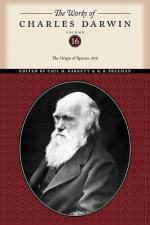
|
| Name: _________________________ | Period: ___________________ |
This test consists of 5 multiple choice questions, 5 short answer questions, and 10 short essay questions.
Multiple Choice Questions
1. Why are the same species of freshwater fish typically NOT found in different countries?
(a) Countries have different environments.
(b) Fish do not migrate.
(c) They are separated by large bodies of salt water.
(d) Fish do not descend from a common ancestor.
2. Which of the following refers to ways by which an organism could spread to a new area that would NOT typically occur naturally?
(a) Accidental means of dispersal.
(b) Human transport.
(c) Artificial migration.
(d) Species changes.
3. What is correlated with a difference in creatures that inhabit a region?
(a) The barriers of that region.
(b) Food supply.
(c) Migration patterns.
(d) Mating potential.
4. Why do scientists believe fossils do not exist at the bottom of the ocean?
(a) No species that far down.
(b) They cannot get to the bottom.
(c) Too much pressure.
(d) Fossils are only found on land.
5. What is one unique characteristic of the European cuckoo?
(a) Cares for other birds' eggs.
(b) Lays eggs in other birds' nests.
(c) Eats eggs.
(d) Buries eggs.
Short Answer Questions
1. What is one river that Darwin gives as an example of one that has dramatically changed over the years?
2. In Geographical Distribution continued, what does Darwin suggest about the rule of natural selection?
3. What is NOT sufficient to account for differences in organisms in different regions?
4. What behaviors have been lost through the domestication of cats and dogs?
5. What does the fossil record suggest about species that go extinct?
Short Essay Questions
1. What is one cause of a landmass changing the geological record?
2. Why do rudimentary organs pose a problem for theorists that species were created independently?
3. How does Darwin explain similarities in embryos?
4. What does Darwin suggest about the fossil records of trilobites?
5. What are some general rules governing whether or not two species can produce fertile offspring?
6. How does the age of the earth play into natural selection?
7. How do physical barriers correlate with differences in creatures that inhabit a region?
8. How does Darwin explain how the same genus of species are found in different geographical regions?
9. What are three facts that can be explained by natural selection as discussed in Chapter 11?
10. What is the key explanation for species living in different regions?
|
This section contains 871 words (approx. 3 pages at 300 words per page) |

|




